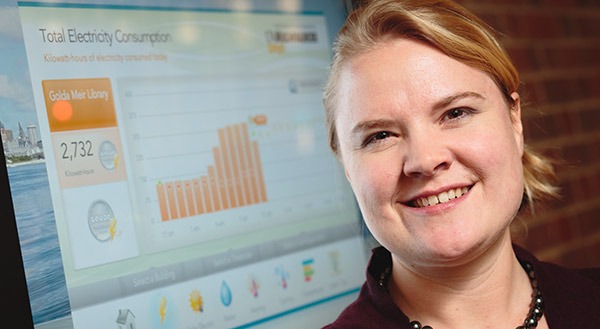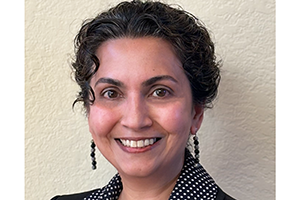
Replacing concrete slabs with a color-saturated rain garden, the UWM storm water master plan has reduced run-off into one of the university’s best natural and academic assets: Lake Michigan.
Planning year two of UWM Sustainability Camp, UWM is showing off its sustainable side to some of the Midwest’s best prospective college students.
Coordinating the first Bicycle Advisory Task Force – members prefer to call it BAT Force – is gradually reducing emissions and parking congestion at UWM.
All of the above is all in a day’s work for UWM Sustainability Chief Kate Nelson. But she’s not in this alone.
“Sustainability efforts at UWM are where they are right now because of strong, campuswide engagement,” Nelson says. “I keep hearing the word ‘intentions,’ now, when we talk about sustainability. That’s a change for us, and we’re achieving better results because of it.”
Use less, save more
One example: Under the first-of-its-kind Energy Matters plan, Nelson helped secure state funding to rehab concrete-laden and energy-inefficient campus buildings for a projected energy-reduction of 25 percent by the end of fiscal year ‘13.
“We achieved 42 percent savings just mid-way through the project.”
Weather-tight doors, motion sensors and new air-filtration systems might sound like details that could excite only an engineer, but under the scope of sustainability, Nelson says they have broader appeal.
“With energy improvements, we’re making buildings more comfortable and improving air quality at the same time. Why garner emissions reductions at UWM if we don’t engage the entire campus at the same time, and make life better here on campus?”
Energy Matters is a $30 million, five-year plan, but Nelson and colleagues in the University Services & Research Building in Glendale, Wis., are just as focused on common-sense “small” stuff.
“It took us five years,” she says, “but we will have outdoor recycling bins this spring.”
Campus gardens in full bloom
In keeping with Milwaukee’s growing profile as a hotbed of urban agriculture, Nelson and the UWM Food & Garden Club broke grass on campus gardens in 2010. Thirty plots are again open this spring to students, faculty and staff on the south lawn of the Physics Building. New to the campus gardens in 2013 are a crop-rotation plan and three hoop houses Restaurant Operations will use to expand its menu of fresh, locally grown foods.
Other gardening partners include the Conservation & Environmental Science program, which operates a year-round teaching garden. The Letters & science program enrolls students looking to work in green industries and sustainable entrepreneurism. It’s helped UWM earn a coveted spot on the Princeton Review’s Guide to Green Colleges for three years running.
“Schools that have a good Green Rating will put graduates a step ahead of the competition and help ready them for the jobs they really want,” according to the review.
Universities run on coffee, and UWM’s own line of Grind coffee shops are fueling sustainability in their own way. The shops grind out 2,000-3,000 pounds of compostable grounds monthly. Most of the brown grounds are delivered to Growing Power to nurture the urban gardens that have helped launch Milwaukee’s grow-your-own culture and deliver fresh produce and gardening expertise to food deserts on the North Side.
Some of those grounds will now be repurposed in one of Restaurant Operations’ hoop houses. With help from Growing Power, Nelson predicts the collaboration will yield high-quality UWM compost.
Planting gardens, populating spreadsheets
Another long-term benefit of campus gardening is community building, says Bruce Wiggins, executive director of Milwaukee Urban Gardens and advisor/contributor to the UWM gardens.
“Kate recognizes that sustainability involves growing food and helping people learn gardening,” Wiggins says. “And doing it in the UWM community. Community gardens build community, and community is part of what we need more these days – learning and growing together.”
Community is key, Nelson agrees, but so is data.
“We’ve always had accounts paying the electricity bills. That’s necessary. But now we’re getting information from all over campus about how energy is used and how much is being used. No longer am I sitting over 50 pages of spreadsheets. Using data earlier, using more data – that’s sustainability, that’s how you build the connections that can make a real difference.”
By 2013 UWM should be a registered user of STARS – the nationwide Sustainability Tracking, Assessment & Rating System for higher education. Nelson appears both exhilarated and intimidated by the opportunity to help departments collect and synthesize data on everything from how much trans fats are served at UWM to student diversity to the teaching of sustainability.
“There’s so much we need to do to just to establish some baseline measures for the full campus,” Nelson says. “But a lot of people look at sustainability report cards in higher education and at the end of this, we’ll have not just a ranking but a tool we can use to analyze our emission reduction, energy savings, student engagement.
“This is important because research and student feedback prove that a sustainable university is the kind of university students want to attend.”







